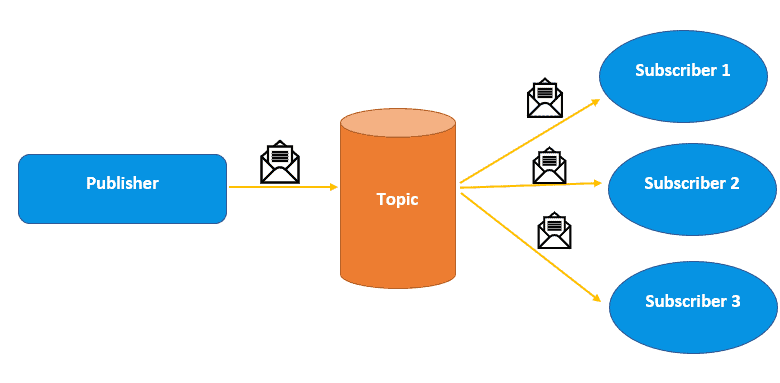1. Introduction
The publisher-subscriber (pub-sub) model is a widely used architectural pattern. We can use it in software development to enable communication between different components in a system.
In particular, it is often used in distributed systems, where different parts of the system need to interact with each other but don’t want to be tightly coupled.
In this tutorial, we’ll explore the pub-sub model, how it works, and some common use cases for this architectural pattern.
2. Pub-Sub Model: Overview
The pub-sub model involves publishers and subscribers, making it a messaging pattern. Specifically, the publishers are responsible for sending messages to the system, while subscribers are responsible for receiving those messages.
Mainly, the pub-sub model is based on decoupling components in a system, which means that components can interact without being tightly coupled.
The following image shows the pub-sub model architecture:

3. How the Pub-Sub Model Works
In this section, we’ll discuss how this model works, including sending messages, checking for subscribers, receiving messages, registering for topics, decoupling publishers and subscribers, and additional features the message broker implements to enhance message delivery.
3.1. Sending Messages
A publisher sends a message to the message broker with a specific topic, which is a string that identifies the content of the message.
3.2. Checking for Subscribers
The message broker receives the message and checks the topic to see if any subscribers have expressed interest in receiving messages on that topic. Furthermore, if subscribers are interested in the topic, the message broker sends the message to all subscribers who have registered interest in that topic.
3.3. Receiving Messages
Subscribers receive the message from the message broker. Then, it can process the message as needed. However, the message is discarded if no subscribers are interested in the topic.
3.4. Registering for Topics
To receive messages on specific topics, subscribers can register interest in one or more topics with the message broker. Additionally, this feature enables subscribers to receive messages on topics they are interested in.
3.5. Decoupling Publishers and Subscribers
Publishers and subscribers do not need to know about each other’s existence since they interact only through the message broker, which acts as an intermediary.
3.6. Additional Features
The message broker can also implement additional features such as filtering messages based on content, ensuring message delivery, and providing message ordering guarantees. These features enhance the reliability and efficiency of message delivery.
By decoupling publishers and subscribers, the pub-sub model allows them to interact through a message broker, which helps to reduce tight coupling between components in a system.
This makes it an ideal messaging pattern for use in distributed systems, where different parts of the system must interact without being tightly coupled.
4. Advantages and Disadvantages of the Pub-Sub Model
The pub-sub model has several benefits. The following table summarizes its main advantages:
Advantage
Description
Scalability
The decoupled nature of the pub-sub model makes it highly scalable. The model can handle a large number of publishers and subscribers without affecting the performance
Reliability
A message broker ensures the reliable delivery of messages to interested subscribers, even if some subscribers are offline or disconnected
Flexibility
The pub-sub model offers high flexibility by enabling the addition or removal of publishers and subscribers without affecting the overall system
Loose coupling
The decoupled nature of the pub-sub model ensures that publishers and subscribers are loosely coupled, which allows them to evolve independently without affecting each other
However, the pub-sub model also has some drawbacks. The following table shows its main drawbacks:
Disadvantage
Description
Increased complexity
The use of a message broker adds complexity to the system, making it more difficult to implement and maintain
Higher latency
The use of a message broker can introduce additional latency into the system, which may be unacceptable for some real-time applications
Single point of failure
The message broker represents a single point of failure for the system, which may result in service disruption if it fails
5. Use Cases for the Pub-Sub Model
In this section, we’ll explore some use cases of this model, including real-time updates in online games, smart homes with IoT, and data distribution in data analytics.
5.1. Real-time Updates in Online Games
One of the use cases for the pub-sub model is online gaming, where publishers can send real-time updates on player positions, score changes, and game events to all subscribers.
Overall, this enhances the gaming experience and ensures all players receive the same updates simultaneously.
5.2. Smart Homes with IoT
The pub-sub model is also used in smart homes to send messages from sensors to actuators. For example, we can use this model to turn on the lights when someone enters a room.
Mainly, this use case demonstrates how the pub-sub model enables communication between different components in an IoT system.
5.3. Data Distribution in Data Analytics
The pub-sub model is ideal for data distribution to different subscribers in data analytics. For instance, financial companies can use it to distribute updates on specific financial instruments in real time to traders subscribed to them.
Generally speaking, this use case highlights how the pub-sub model can disseminate information across various organizational departments.
6. Conclusion
In conclusion, if we’re looking for a robust and reliable pattern for software development, the pub-sub model should be on your radar.
Moreover, its versatility enables components to interact without being tightly coupled, providing flexibility, scalability, and reliability.